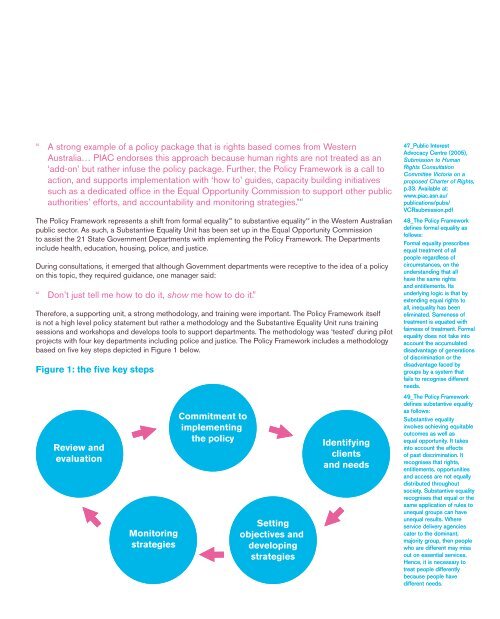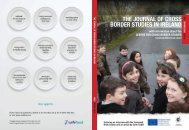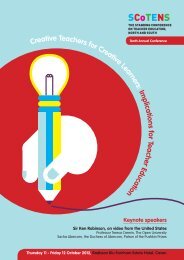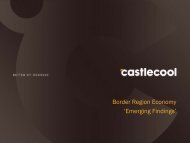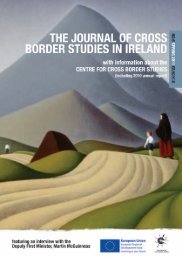improving government service delivery to minority ethnic ... - NCCRI
improving government service delivery to minority ethnic ... - NCCRI
improving government service delivery to minority ethnic ... - NCCRI
You also want an ePaper? Increase the reach of your titles
YUMPU automatically turns print PDFs into web optimized ePapers that Google loves.
“ A strong example of a policy package that is rights based comes from Western<br />
Australia… PIAC endorses this approach because human rights are not treated as an<br />
‘add-on’ but rather infuse the policy package. Further, the Policy Framework is a call <strong>to</strong><br />
action, and supports implementation with ‘how <strong>to</strong>’ guides, capacity building initiatives<br />
such as a dedicated office in the Equal Opportunity Commission <strong>to</strong> support other public<br />
authorities’ efforts, and accountability and moni<strong>to</strong>ring strategies.” 47<br />
The Policy Framework represents a shift from formal equality 48 <strong>to</strong> substantive equality 49 in the Western Australian<br />
public sec<strong>to</strong>r. As such, a Substantive Equality Unit has been set up in the Equal Opportunity Commission<br />
<strong>to</strong> assist the 21 State Government Departments with implementing the Policy Framework. The Departments<br />
include health, education, housing, police, and justice.<br />
During consultations, it emerged that although Government departments were receptive <strong>to</strong> the idea of a policy<br />
on this <strong>to</strong>pic, they required guidance, one manager said:<br />
“ Don’t just tell me how <strong>to</strong> do it, show me how <strong>to</strong> do it.”<br />
Therefore, a supporting unit, a strong methodology, and training were important. The Policy Framework itself<br />
is not a high level policy statement but rather a methodology and the Substantive Equality Unit runs training<br />
sessions and workshops and develops <strong>to</strong>ols <strong>to</strong> support departments. The methodology was ‘tested’ during pilot<br />
projects with four key departments including police and justice. The Policy Framework includes a methodology<br />
based on five key steps depicted in Figure 1 below.<br />
Figure 1: the five key steps<br />
Review and<br />
evaluation<br />
Moni<strong>to</strong>ring<br />
strategies<br />
Commitment <strong>to</strong><br />
implementing<br />
the policy<br />
Setting<br />
objectives and<br />
developing<br />
strategies<br />
Identifying<br />
clients<br />
and needs<br />
47_Public Interest<br />
Advocacy Centre (2005),<br />
Submission <strong>to</strong> Human<br />
Rights Consultation<br />
Committee Vic<strong>to</strong>ria on a<br />
proposed Charter of Rights,<br />
p.33. Available at:<br />
www.piac.asn.au/<br />
publications/pubs/<br />
VCRsubmission.pdf<br />
48_The Policy Framework<br />
defines formal equality as<br />
follows:<br />
Formal equality prescribes<br />
equal treatment of all<br />
people regardless of<br />
circumstances, on the<br />
understanding that all<br />
have the same rights<br />
and entitlements. Its<br />
underlying logic is that by<br />
extending equal rights <strong>to</strong><br />
all, inequality has been<br />
eliminated. Sameness of<br />
treatment is equated with<br />
fairness of treatment. Formal<br />
equality does not take in<strong>to</strong><br />
account the accumulated<br />
disadvantage of generations<br />
of discrimination or the<br />
disadvantage faced by<br />
groups by a system that<br />
fails <strong>to</strong> recognise different<br />
needs.<br />
49_The Policy Framework<br />
defines substantive equality<br />
as follows:<br />
Substantive equality<br />
involves achieving equitable<br />
outcomes as well as<br />
equal opportunity. It takes<br />
in<strong>to</strong> account the effects<br />
of past discrimination. It<br />
recognises that rights,<br />
entitlements, opportunities<br />
and access are not equally<br />
distributed throughout<br />
society. Substantive equality<br />
recognises that equal or the<br />
same application of rules <strong>to</strong><br />
unequal groups can have<br />
unequal results. Where<br />
<strong>service</strong> <strong>delivery</strong> agencies<br />
cater <strong>to</strong> the dominant,<br />
majority group, then people<br />
who are different may miss<br />
out on essential <strong>service</strong>s.<br />
Hence, it is necessary <strong>to</strong><br />
treat people differently<br />
because people have<br />
different needs.


